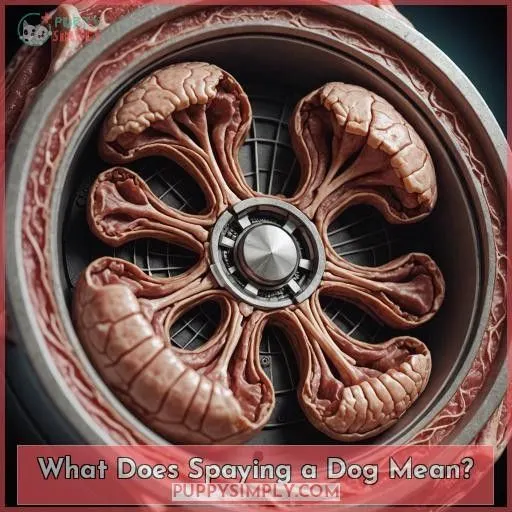This site is supported by our readers. We may earn a commission, at no cost to you, if you purchase through links.
 No, spayed dogs do not have periods.
No, spayed dogs do not have periods.
Spaying involves the surgical removal of a female dog’s ovaries and uterus, preventing heat cycles and menstruation.
While unspayed dogs experience bloody vaginal discharge during their heat cycles every 6-8 months, spayed dogs lack the reproductive organs needed for this process.
However, some spayed dogs may exhibit signs resembling a period due to ovarian remnant syndrome.
To understand what happens to a female dog’s reproductive system after spaying and learn about the benefits, it is best to keep exploring this topic.
Table Of Contents
- Key Takeaways
- Do Spayed Dogs Have Periods?
- Understanding the Dog Heat Cycle
- What Does Spaying a Dog Mean?
- Do Spayed Dogs Go Into Heat?
- Signs of Heat in Dogs
- Benefits of Spaying Your Dog
- What to Expect After Spaying Your Dog
- Do Female Dogs Have Periods?
- What Happens During a Female Dog’s Period?
- Scheduling a Checkup for Your Spayed Dog
- Frequently Asked Questions (FAQs)
- Conclusion
Key Takeaways
- Spaying a female dog involves the surgical removal of the ovaries and uterus, preventing heat cycles and menstruation.
- Spayed dogs do not experience heat cycles or periods, as they lack the reproductive organs needed for this process.
- Some spayed dogs may exhibit signs resembling a period due to a condition called ovarian remnant syndrome, which requires veterinary attention.
- The benefits of spaying, such as preventing unwanted pregnancies and reducing the risks of certain cancers, generally outweigh the potential risks associated with the procedure.
Do Spayed Dogs Have Periods?
No, spayed dogs don’t have periods. Spaying a dog involves removing the ovaries and uterus, which eliminates the heat cycle and menstrual bleeding that intact female dogs experience.
Understanding the Dog Heat Cycle
As a female dog owner, you should understand your pup’s heat cycle. Dogs typically experience their first heat between 6 months and 1 year of age.
The cycle recurs every 6 months.
The cycle has 4 stages – proestrus, estrus, diestrus, and anestrus.
During proestrus, your dog’s vulva will swell and she’ll have bloody discharge.
Estrus is when she’s receptive to mating.
Knowing these stages can help you manage your dog’s heat cycle and prevent unwanted behaviors or pregnancies.
What Does Spaying a Dog Mean?
Now that you have a grasp of the fundamentals of a female dog’s heat cycle, let’s delve into what spaying actually involves.
Spaying is a surgical procedure that removes a dog’s uterus and ovaries, preventing unwanted pregnancies and decreasing the risk of certain cancers.
The recommended time to spay your pup is typically before their first heat, around 5-6 months for smaller breeds and 5-15 months for larger breeds.
While there are some risks involved, the advantages of spaying usually surpass them, leading to a healthier, more contented dog.
Do Spayed Dogs Go Into Heat?
If your dog has been spayed, you can rest assured she’ll no longer experience heat cycles.
Spaying removes the ovaries and uterus, eliminating the hormones that trigger the heat cycle. Without these reproductive organs, a spayed dog simply won’t go into heat.
However, if your spayed dog exhibits signs of heat like swelling, bleeding, or behavioral changes, it could indicate an underlying health issue like ovarian remnant syndrome.
In this case, it’s best to consult your veterinarian to determine the cause and get appropriate treatment.
Signs of Heat in Dogs
As your female dog enters her heat cycle, you may notice some telltale signs. Her vulva may become swollen and red, and she may experience bloody discharge. Behavioral changes are also common, like increased urination, affection, or even aggression. Your dog may also try to escape the home in search of a mate. These signs indicate your pup is fertile and receptive to breeding. Keeping a diligent eye on your dog during this time is essential to avert unwanted pregnancies and maintain her well-being.
- Swollen, red vulva
- Bloody vaginal discharge
- Increased urination and marking
- Attempts to escape and find a mate
Benefits of Spaying Your Dog
Spaying your dog prevents unwanted pregnancies, eliminating the difficulties and risks associated with pregnancy and birthing. It also markedly lowers the risk of several reproductive cancers, including mammary, ovarian, and uterine cancers, thereby enhancing your dog’s overall health and longevity.
Benefits of Spaying Your Dog
Spaying your dog offers numerous benefits. It prevents unwanted pregnancies and reduces the risk of mammary, uterine, and ovarian cancers. Spaying also curbs undesirable behaviors linked to heat cycles. While the timing depends on your dog’s breed and lifestyle, spaying an older dog is still beneficial. The cost varies, but the health payoffs make it a wise investment.
Prevents Unwanted Pregnancies
Spaying your dog prevents unwanted litters, reducing the staggering population growth that leads to countless homeless pets. While the surgery carries potential risks like surgical complications, it eliminates the dangers of uterine infections, rapid births, and anesthetic complications that come with unplanned pregnancies. Spaying is a responsible choice that protects your dog’s health and helps control the pet overpopulation crisis.
Reduces Cancer Risks
Spaying your dog can greatly reduce their risk of developing certain cancers. Early spaying, before the first heat cycle, lowers the chances of mammary and reproductive organ cancers. The procedure removes the ovaries and uterus, eliminating the reproductive hormones that fuel the growth of cancerous tumors. This preventative measure protects your dog’s long-term health.
Eliminates Heat Cycles
Spaying eliminates your dog’s heat cycles, preventing the messy bleeding and unwanted mating behaviors. It also reduces the risk of reproductive cancers. While the surgery carries some risks, the long-term health benefits of spaying generally outweigh them. Just be sure to follow your vet’s guidance on the ideal timing and provide proper post-spaying care.
What to Expect After Spaying Your Dog
After your dog’s spaying surgery, you can expect some changes as they recover. Be prepared to keep them calm and limit activity for 10-14 days. Carefully monitor the incision site for signs of infection or internal bleeding. Your vet may prescribe pain medication to keep your pup comfortable. Small-breed dogs tend to recover faster than larger breeds. With proper wound care and a gradual return to normal activity, your spayed dog will be back to their playful self in no time!
- Restrict activity during recovery
- Watch for surgical complications
- Manage pain with vet-prescribed meds
Do Female Dogs Have Periods?
You might wonder if female dogs experience periods like humans. The answer is no – female dogs go through heat cycles instead of monthly periods. Spayed dogs don’t experience heat cycles or any form of menstrual bleeding since their reproductive organs have been surgically removed.
Do Female Dogs Have Periods Every Month?
No, female dogs don’t have periods every month like humans. Dogs experience heat cycles or estrus every 6-12 months, not a monthly menstrual cycle. During this time, they may have some vaginal bleeding, but it’s not a true period. The frequency and duration of a dog’s heat cycle can vary by breed and individual.
| Spay Age | Spay Risks | Spay Recovery |
|---|---|---|
| 5-6 months | Surgical/anesthetic complications | 10-14 days restricted activity |
| 5-15 months | Increased cancer risk | Avoid baths until stitches heal |
Do Female Dogs Have Periods After Being Spayed?
After being spayed, your dog may experience a short period of bleeding as her hormones adjust. This is normal and nothing to worry about. However, if the bleeding persists or your dog shows other signs of heat, it’s important to consult your vet. They can check for:
- Ovarian remnants
- Incomplete spaying
- Hormonal imbalances
- Health problems
Your vet can provide the right treatment to get your spayed pup back to her usual self.
What Happens During a Female Dog’s Period?
During her heat cycle, your dog may experience some bleeding from her vulva that can last 3-12 days.
This is normal and not the same as a human period.
You can help keep her clean and comfortable by using dog-specific period products like washable pads or disposable diapers.
Be sure to limit her exposure to male dogs and provide extra attention, as she may also exhibit mood changes and increased urination during this time.
With the right care, you can help your pup get through her heat cycle with minimal fuss.
Scheduling a Checkup for Your Spayed Dog
After your dog’s spaying procedure, it’s important to schedule a checkup with your veterinarian. This allows them to verify your pup’s incision is healing properly and monitor for any potential health risks. Your vet can provide guidance on:
- Proper post-op care and activity restrictions during recovery
- Spaying options that may be most suitable for your dog’s individual needs
- Addressing any concerns or questions you have about your dog’s health and wellbeing
Staying on top of your spayed dog’s veterinary visits helps keep them happy and healthy long-term.
Frequently Asked Questions (FAQs)
How do I care for my dog during her heat cycle?
As heat’s tides roll in, calm seas require proper navigation. Keep her clean, limit outdoor time, use doggy diapers, and provide calming treats – smooth sailing ahead!
Can spaying a dog cause any long-term health issues?
Yes, spaying can increase risks like urinary incontinence, certain cancers, and joint disorders. However, reputable vets recommend spaying as benefits outweigh risks for most dogs.
How can I prevent my dog from escaping during heat?
To prevent escape during heat, crate or confine your unspayed dog when unattended. Consider doggy diapers or doggy pants to manage any mess. Ultimately, spaying eliminates heat cycles altogether.
What are the signs that my spayed dog may have a health problem?
Ironically, a spayed dog exhibiting heat signs like swollen vulva or bloody discharge could indicate an underlying health issue. Promptly consult your vet for proper diagnosis and treatment.
How often should I take my spayed dog for a checkup?
You should take your spayed dog for an annual wellness exam. This allows your vet to monitor her health, check for any issues, and provide preventive care recommendations.
Conclusion
Ultimately, around 90% of spayed dogs won’t experience heat cycles or periods. Spaying your dog eliminates her ability to go into heat and prevents bloody discharge associated with menstrual cycles. While ovarian remnant syndrome can occasionally mimic heat signs in spayed dogs, it’s uncommon. By understanding that spayed dogs don’t typically have periods, you’ll know what to expect after the procedure.














